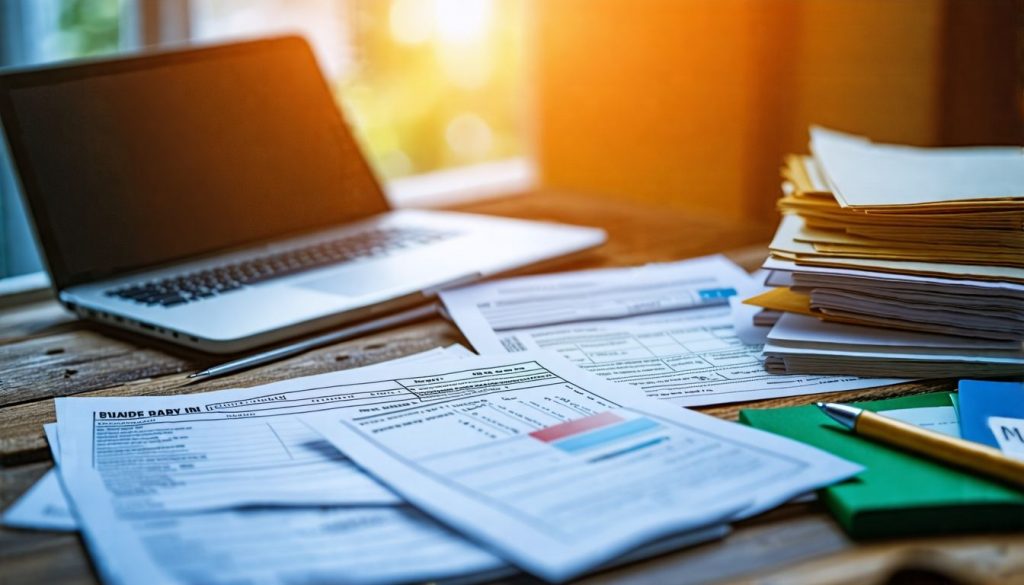Struggling to keep your credit card balance in check is a common challenge many face. Interestingly, the average credit card debt is a pressing issue for individuals aiming to maintain financial health.
Our article breaks down the basics of understanding your credit card balance, offering guidance on management and impact on your credit score. Stay informed; read on!
Key Takeaways
- Your credit card balance includes purchases, fees, and interest charges, but payments you make reduce this total. Managing your balance wisely can help avoid high debt.
- Different factors like purchases, payments, cash advances, and fees all affect how much you owe on your credit card. Keeping track of these can improve your financial health.
- Knowing the difference between statement balance and current balance is crucial for managing spending and avoiding going over your limit.
- Checking your credit card balance regularly through online banking, mobile apps, or paper statements helps you stay informed and manage finances better.
- Paying more than the minimum payment each month on your credit card can save money in interest and reduce debt faster.
What is a Credit Card Balance and How Is It Calculated?
A credit card balance is the total amount of money you owe to your credit card issuer. It gets calculated by adding up all your purchases, fees, and interest charges while subtracting any payments you’ve made.
Definition of credit card balance
A credit card balance refers to the total amount you owe on your credit card at any given time. This outstanding balance can include various charges, such as purchases and interest accrued, minus any payments made.
To determine the current balance, issuers evaluate transactions within a billing cycle and update accordingly.
Understanding how this balance works is essential for effective financial management. It plays a significant role in calculating your credit utilization ratio, which impacts your overall credit score.
Familiarity with these numbers helps maintain healthy financial habits as we explore different types of balances in the following section.
Managing your credit card balance wisely can lead to better financial outcomes.
Factors used in calculating the balance
Understanding how credit card balances are calculated helps you manage your money better. Several important factors contribute to your credit card balance.
- Purchases: Each time you make a purchase using your credit card, that amount is added to your balance. Keep track of these transactions, as they directly impact what you owe.
- Payments: Any payments made toward the credit card reduce the outstanding balance. Paying more than the minimum payment can help decrease your balance faster and save on interest.
- Interest Rates: Credit cards usually have high-interest rates that apply to any unpaid balances each month. The longer you carry a balance, the more interest accumulates, increasing what you owe.
- Fees: Various fees can be added to your balance, such as late fees or annual fees. These charges add up quickly and should be factored into your total balance.
- Credit Limit: This represents the maximum amount you can charge on your card. If your purchases exceed this limit, it might lead to declined transactions or over-limit fees.
- Statement Balance vs Current Balance: The statement balance reflects what was owed at the end of a billing cycle, while the current balance updates in real-time based on new purchases and payments made since then.
- Cash Advances: If you withdraw cash using your credit card, that amount gets added immediately to your balance along with any associated fees and higher interest rates compared to regular purchases.
- Balance Transfers: Moving debt from one credit card to another through a balance transfer offer changes how much you owe on each account but may also come with fees or special interest rates affecting the overall calculation of balances.
Monitoring these factors will give Canadians a clearer picture of their financial health regarding their credit cards.
Example calculation
To calculate your credit card balance, consider all transactions made during the billing cycle. For instance, if you had an initial balance of $500 and made purchases totaling $300, your new balance would be $800.
If you then made a payment of $200 before the payment due date, your final balance would amount to $600.
Transactions such as payments or new charges directly impact your account balance. A good grasp of how these factors work will help you manage available credit more effectively and avoid exceeding your credit limit.
Regularly reviewing your credit card statement can aid in keeping track of balances and understanding potential interest charges on any remaining amounts.
Different Types of Credit Card Balances
Different types of credit card balances can affect your financial decisions. Each balance type has unique features that influence how you manage your payments and spending habits.
Statement balance
The statement balance is the total amount you owe on your credit card as of the last billing cycle. This figure includes all purchases, payments, interest charges, and fees incurred during that period.
Your statement balance provides a clear snapshot of your debt at a specific point in time.
Understanding this balance is crucial for managing your credit card payment effectively. A high statement balance can impact your credit score negatively if it approaches or exceeds your credit limit.
To avoid potential penalties and maintain good standing, aim to pay off the entire statement balance each month whenever possible.
Current balance
The current balance represents the total amount you owe on your credit card at any given moment. This figure fluctuates with each transaction, including purchases, payments, and fees.
For Canadians using their credit cards regularly for everyday expenses or rewards programs, tracking this balance is crucial.
Knowing your current balance helps you manage your spending effectively and avoid exceeding your credit card limit. High balances can negatively impact your credit score, making it essential to keep this figure in check.
Keeping track of these changes can also prevent unexpected charges when utilizing a credit card balance transfer offer or considering future transactions.
Minimum monthly payment
The minimum monthly payment is the smallest amount you must pay on your credit card each month to remain in good standing. This figure usually consists of a percentage of your total balance, plus any interest or fees accrued during that period.
Credit card issuers often calculate this as either 2% to 5% of your outstanding balance or a fixed dollar amount, whichever is greater.
Making only the minimum monthly payment can prolong debt repayment and increase overall interest costs. Over time, paying just the minimum can lead to significant financial strain due to accumulating interest charges.
Managing credit card rewards effectively involves understanding how payments impact balances and choosing strategies that help reduce total debt more quickly while maximizing benefits.
Negative balance
A negative balance occurs when a credit card account has a surplus of funds. This can happen if you’ve paid more than your total statement balance or received a refund on purchases.
For example, if your statement balance is $500 and you pay $700, your account shows a negative balance of $200.
Having a negative balance means you have money available for future purchases or it can be credited toward the next billing cycle. It effectively reduces the amount you’ll owe in upcoming statements.
Understanding this aspect helps Canadians manage their financial situations better, especially regarding credit card transactions.
How to Check and Manage Your Credit Card Balance
You can check your credit card balance easily online, by phone, or through paper statements. Managing your balance helps you stay within limits and protect your credit score from damage.
Checking your balance online, through phone, or on paper statements
Checking your credit card balance is essential for managing your finances effectively. Canadians have several methods to stay informed about their balances.
- Online Banking: Most banks provide online banking services. Log into your account using a secure password. You will find real-time updates on your credit card balance, transactions, and payment due dates.
- Mobile Apps: Many financial institutions offer mobile apps for easy access. Download the app linked to your bank account. These apps often send notifications about your balance and payment reminders, making it convenient to manage what you owe.
- Phone Services: Time-efficient phone services are available in Canada as well. Call the customer service number found on the back of your credit card to check your balance anytime. A representative can provide details or direct you through an automated system.
- Paper Statements: Monthly statements will provide a summary of your credit card activity and balance due. Review these statements carefully when they arrive in the mail or download them from your online account for reference.
- Email Alerts: Subscribing to email notifications helps keep track of any changes to your balance or upcoming payments. Set up alerts on transactions or low balances so you can respond quickly and avoid high fees.
- ATM Access: Some ATMs display your credit card balance when you use them for cash advances or withdrawals against available credit limits. This method serves as a quick check when you’re out and about.
- Credit Monitoring Services: Using a third-party service can offer additional insights into all aspects of your credit profile, including balances across different cards. These services often provide alerts if there are significant changes in any accounts, helping you manage effectively.
Utilizing these various methods ensures that Canadians stay updated on their credit card balances, allowing better financial decisions and management strategies related to Understanding the Basics of Credit Card Balance.
Understanding how a high balance affects your credit score
A high credit card balance can negatively impact your credit score. Credit scoring models typically consider the credit utilization ratio, which is the amount of available credit that you are using.
Keeping this ratio below 30% is generally recommended for maintaining a healthy score. If you consistently carry high balances, lenders may view you as a greater risk, making it challenging to secure loans or favorable interest rates in the future.
Monitoring your balance closely and making payments on time can help improve your financial standing. It’s crucial to strike a balance between using your credit wisely and ensuring that it doesn’t hinder your ability to achieve financial goals.
Understanding different types of credit card balances will further empower you in managing your finances effectively.
Tips for managing a high balance
Managing a high credit card balance can feel overwhelming. Staying proactive with your finances keeps you on track.
- Set a Budget
Define how much money you can spend each month. Stick to this limit to avoid accumulating more debt.
- Make More Than the Minimum Payment
Paying only the minimum extends the time it takes to pay off your balance and increases interest costs. Aim for larger payments whenever possible.
- Prioritize Your Payments
Focus on cards with the highest interest rates first. Reducing these balances faster will save you money in interest over time.
- Track Your Spending
Keep an eye on where your money goes each month. This helps identify unnecessary expenses that can be cut back or eliminated.
- Set Up Alerts
Use your bank’s mobile app or website to set alerts for due dates and low balances. This prevents missed payments and late fees, which can add to your balance.
- Consider Balance Transfers
Look for credit cards that offer low or zero introductory rates for balance transfers. However, read the fine print, as fees may apply after a promotional period ends.
- Avoid Unnecessary Purchases
Limit using your credit card for non-essential purchases while you’re managing a high balance. Keep spending focused on essentials until you’re in a better financial position.
- Seek Professional Help if Needed
Consult a financial advisor if managing your credit feels unmanageable. They can provide tailored advice based on your situation and help create an action plan.
- Utilize Automatic Payments
Setting up automated payments ensures bills are paid on time without manual intervention, helping maintain good standing with lenders.
- Review Your Credit Card Statements Regularly
Take time each month to review statements closely for any errors or unauthorized charges that could increase your balance unnecessarily.
Striking a Balance and Final Thoughts
Paying off your credit card balance is crucial. It affects both your budget and your credit score significantly. Understanding the implications of carrying a balance can help you make better financial choices moving forward.
Establishing good habits around managing debt will lead to long-term success in maintaining financial health.
Importance of paying off your credit card balance
Paying off your credit card balance is essential for maintaining financial health. Credit cards often carry high-interest rates, which can lead to significant debt if balances are not managed properly.
Carrying a balance means you incur interest charges, which add up over time and can make it difficult to pay down the principal amount owed.
Keeping your balance low or paying it off in full each month helps improve your credit score. A lower utilization ratio reflects responsible borrowing habits, making you more attractive to lenders.
Prioritizing timely payments also ensures that you avoid penalties and late fees, further supporting sound financial management.
Considerations for carrying a balance
Carrying a balance on your credit card can impact your financial health. The interest rates on credit cards in Canada can be high, typically ranging from 19.99% to 29.99%. This means that any unpaid balance accrues significant interest charges, making it harder to pay off debt over time.
A high outstanding balance also negatively affects your credit utilization ratio, which is a key component of your overall credit score.
Choosing to carry a balance requires careful consideration. It is crucial to assess whether the benefits, such as rewards points or cashback offers, outweigh the accumulating interest costs.
If not managed properly, ongoing debt may lead to financial strain and limit future borrowing ability. Keeping track of spending habits and setting limits can help maintain control over balances while avoiding costly pitfalls associated with carrying debt.
Conclusion
Understanding the implications of carrying a credit card balance is essential. Striking a balance between convenience and financial responsibility can significantly affect your overall financial health.
Paying off your credit card balance in full each month helps avoid interest charges and builds a positive credit history. This practice fosters good spending habits that support long-term financial success.
Prioritizing this approach empowers you to use credit wisely while minimizing debt-related stress.
FAQs
Apologies for the confusion, but it seems that there are no keywords provided for Article 2. Could you please provide them so I can generate appropriate FAQs?








